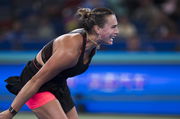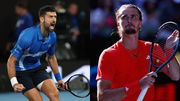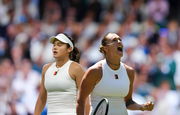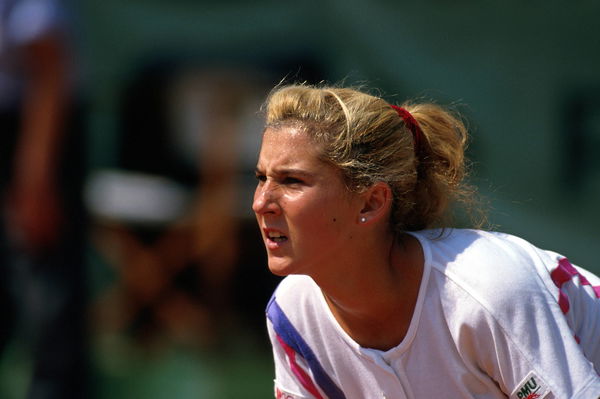
Imago
Novak Djokovic (SRB) serves against Matteo Berrettini (ITA) in the final of the Gentlemen’s Singles on Centre Court at The Championships 2021. Held at The All England Lawn Tennis Club, Wimbledon. Day 13 Sunday 11/07/2021. Credit: AELTC/Joe Toth

Imago
Novak Djokovic (SRB) serves against Matteo Berrettini (ITA) in the final of the Gentlemen’s Singles on Centre Court at The Championships 2021. Held at The All England Lawn Tennis Club, Wimbledon. Day 13 Sunday 11/07/2021. Credit: AELTC/Joe Toth
The fresh grass at Centre Court beckons for the 138th edition of Wimbledon. Since its 1877 inception, this grand 148-year-old tournament has crowned true legends. In the Open Era, Roger Federer reigns supreme with 8 Gentlemen’s Singles titles, closely followed by Novak Djokovic and Pete Sampras, each with 7. On the ladies’ side, Martina Navratilova holds an unmatched 9 singles titles, while Steffi Graf and Serena Williams boast 7 apiece, solidifying their dominance on these hallowed lawns. But with every victor stood a runner-up who came close to tasting glory. Here are five players who never made it.
Watch What’s Trending Now!
1. American ex-pro Andy Roddick – three finals
Roddick has reinvented himself as the sharp, funny voice behind the ‘Served’ podcast, where he unpacks tennis drama with the kind of candid insight only a 13-season pro brings—he turned professional in 2000 and officially retired from singles at the 2012 US Open, on his 30th birthday. When he blitzed through the 2003 US Open as a 21-year-old powerhouse, Wimbledon seemed destined to be his next conquest.
ADVERTISEMENT
But just as Roddick’s star was rising, Roger Federer’s reign at Wimbledon began, and Roddick lost finals to the maestro in 2004 and 2005. As the Big Four era took hold, his shot at a second major—especially at Wimbledon—looked gone. Then, in 2009, Nadal’s withdrawal opened the draw, and Roddick seized the moment, beating Murray in the semis to face Federer again.
Thread: Ranking the Top 10 Players to never win Wimbledon 🧵
(And telling the stories of why they didn’t) pic.twitter.com/GptILm0r8k
— Oscar (@SlidingBackhand) June 24, 2025
Roddick battled back to take the 4th set, but would lose the 5th 16-14 when he was broken for the first time in his 38th service game of the match. His gracious, humorous post-match interview remains one of Wimbledon’s most tear-jerking moments, and his 41-12 record there is a testament to both his talent and the heartbreak of being so close, so many times.
ADVERTISEMENT
2. Tennis legend Ivan Lendl – two finals
Lendl is the ultimate what-if at Wimbledon. The Czech legend dominated the 1980s as the most determined, hard-working, and successful male player, racking up 270 weeks at number 1 and reaching 19 major finals—both records at the time. He went all out for Wimbledon, even remodeling his game and skipping Roland Garros twice late in his career just to prep for the grass.
ADVERTISEMENT
With a stellar 48-14 record at the All England Club, Lendl proved himself a force on the surface. But despite his commitment, he kept running into roadblocks like John McEnroe, Boris Becker, Stefan Edberg, and Pat Cash in the latter rounds.
Top Stories
Aryna Sabalenka’s Battle of Sexes Participation Receives Criticism From Top Coach

WTA Player’s Misbehavior With Ball Kid Triggers Backlash From Former Tennis Pro

Novak Djokovic Labeled the Safer Bet for Slam Glory Than Alexander Zverev in a Bold Prediction

Aryna Sabalenka Breaks Silence on Nationality Switch After Belarus Representation Ban

Emma Raducanu Told to Follow in Aryna Sabalenka’s Footsteps as She Looks for Career Revival

His best results at Wimbledon were back-to-back finals in 1986 and 1987, but he just couldn’t break through for the title. His most famous near miss was the 1989 semi-final against Boris Becker, where he grabbed a 2 sets to 1 lead over the two-time champ, only to see Becker storm back in sets four and five, much to Lendl’s clear disappointment. Still, with eight other major titles to his name and a Wimbledon record better than most serve-and-volleyers’ results at Roland Garros, it’s hard to imagine a player as consistent, dogged, and skilled as Lendl not completing his trophy haul in another era.
ADVERTISEMENT
3. The all-court specialist Ken Rosewall – four finals
Rosewall was a titan of his era, racking up Grand Slam titles right through the 1970s—four Australian Opens (1953, 1955, 1971, 1972), two French Opens (1953, 1968), and two US Opens (1956, 1970). But the one prize that always slipped through his fingers was Wimbledon, despite four finals appearances across an astonishing 20-year span. He missed the tournament a staggering 13 times, with 11 of those absences coming during his prime years on the pro circuit, a twist that only made his Wimbledon quest more dramatic.
He teamed up with fellow Aussie legends like Rod Laver, Lew Hoad, Roy Emerson, and John Newcombe to form the golden era that dominated tennis from the 1950s well into the early 1970s. “Muscles” earned his nickname with a legendary backhand and incredible longevity—he’s both the youngest and oldest man to ever win the Australian Open. He lost his early Wimbledon finals to Jaroslav Drobny and Hoad in 1954 and 1956, then took a long break from the Championships while playing professionally, only to return in 1968 and keep chasing that elusive title.
At 39, Rosewall made a stunning run to the 1974 final, beating Newcombe and Stan Smith before falling to a young Jimmy Connors. Even in unofficial events, like the 1967 “Wimbledon Pro,” he lost to his great rival Laver. With 44 grass court titles—six of them Slams—plus a stack of wins on wood surfaces, Rosewall was a master of every court.
ADVERTISEMENT
4. WTA legend Monica Seles – one final
Seles was an absolute phenomenon, grabbing a remarkable nine Grand Slam singles titles during her stellar career: four Australian Opens (1991, 1992, 1993, 1996), three French Opens (1990, 1991, 1992), and two US Opens (1991, 1992). Yet, for all her dominance, Wimbledon remained the elusive prize, despite coming agonizingly close. Her powerful, two-handed groundstrokes were pure magic on hard and clay courts, but the unique challenge of grass proved a tougher nut to crack.
From 1991 until her tragic stabbing in 1993, Monica Seles was on an unparalleled tear, winning seven of the nine majors played. Her two “misses” during this period both involved Wimbledon: she sat out the 1991 edition with shin splints, and then, in 1992, she made it all the way to the final, only to lose to Steffi Graf. This final was famously overshadowed by “gruntgate,” with the British press and opponents like Navratilova complaining about her on-court vocalizations. Seles played the final in silence, seemingly fearing backlash on tennis’s biggest stage.
ADVERTISEMENT

Imago
Bildnummer: 00176056 Datum: 18.03.1990 Copyright: imago/Claus Bergmann
Monica Seles (USA) konzentriert; quer, Monika, Lipton Open 1990, WTA Tour, Hartplatz, Hardcourt, Hartplatzturnier, Hartplatztennis Key Biscayne, Miami Konzentration, Tennis Damen Einzel USA Porträt Aktion Personen
With a strong 30-9 Wimbledon record and a 77% winning percentage on grass, Seles clearly had the game, even reaching the quarterfinals four other times (1990, 1998, 2000, 2002). While a grass-court title outside of Wimbledon eluded her, many believe that had fate been kinder, her sheer dominance in the early 90s would have eventually led her to hoist that Wimbledon trophy.
ADVERTISEMENT
5. The best single backhander, Justine Henin – two finals
Henin was famous for her extraordinary one-handed backhand, praised by John McEnroe as “the best single-handed backhand in both the women’s or men’s game.” Despite her small stature, she had a complete all-court game, blending power, touch, mental toughness, and exceptional footwork — earning comparisons to Roger Federer. Her dominance on clay was clear, winning the French Open four times (2003, 2005, 2006, 2007) and capturing seven Grand Slam singles titles overall, including two US Opens and one Australian Open.
Wimbledon, however, remained her toughest challenge. With a 30-8 record and finals in 2001 and 2006, she was elite on grass but couldn’t clinch the title. From 2001 to 2008, she reached two finals and three semis, facing fierce rivals like Venus and Serena Williams and Amélie Mauresmo, who all denied her the crown. After a virus kept her out in 2004 and a shock early exit in 2005, she made a strong comeback before retiring, playing just once more at Wimbledon in 2010, losing to compatriot Kim Clijsters.
Many have faced heartbreak on Centre Court, but now it’s time for a fresh chapter. Carlos Alcaraz returns as the two-time defending men’s champion, while Barbora Krejčíková steps back in as the reigning women’s champion. The stage is set, the excitement is building — who will claim the crowns this year? All will be revealed in the coming weeks.
ADVERTISEMENT
ADVERTISEMENT
ADVERTISEMENT
ADVERTISEMENT

